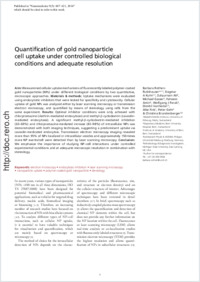Quantification of gold nanoparticle cell uptake under controlled biological conditions and adequate resolution
- Rothen-Rutishauser, Barbara Adolphe Merkle Institute & University of Fribourg, Switzerland - Respiratory Medicine, Bern University Hospital, Bern, Switzerland
- Kuhn, Dagmar A Adolphe Merkle Institute & University of Fribourg, Switzerland - Institute of Anatomy, University of Bern, Bern, Switzerland
- Ali, Zulqurnain Fachbereich Physik & WZMW, Philipps Universität Marburg, Marburg, Germany
- Gasser, Michael Institute of Anatomy, University of Bern, Bern, Switzerland
- Amin, Faheem Fachbereich Physik & WZMW, Philipps Universität Marburg, Marburg, Germany
- Parak, Wolfgang J Fachbereich Physik & WZMW, Philipps Universität Marburg, Marburg, Germany
- Vanhecke, Dimitri Adolphe Merkle Institute & University of Fribourg, Switzerland - Institute of Anatomy, University of Bern, Bern, Switzerland
- Petri-Fink, Alke Adolphe Merkle Institute & University of Fribourg, Switzerland
- Gehr, Peter Institute of Anatomy, University of Bern, Bern, Switzerland
- Brandenberger, Christina Institute of Anatomy, University of Bern, Bern, Switzerland - Pathobiology & Diagnostic Investigation, Michigan State University, East Lansing,MI, USA
-
05.06.2013
Published in:
- Nanomedicine. - 2014, vol. 9, no. 5, p. 607–621
English
Aim: We examined cellular uptake mechanisms of fluorescently labeled polymer-coated gold nanoparticles (NPs) under different biological conditions by two quantitative, microscopic approaches. Materials & methods: Uptake mechanisms were evaluated using endocytotic inhibitors that were tested for specificity and cytotoxicity. Cellular uptake of gold NPs was analyzed either by laser scanning microscopy or transmission electron microscopy, and quantified by means of stereology using cells from the same experiment. Results: Optimal inhibitor conditions were only achieved with chlorpromazine (clathrin-mediated endocytosis) and methyl-β-cyclodextrin (caveolin-mediated endocytosis). A significant methyl-β-cyclodextrin-mediated inhibition (63–69%) and chlorpromazine-mediated increase (43–98%) of intracellular NPs was demonstrated with both imaging techniques, suggesting a predominant uptake via caveolin-medicated endocytois. Transmission electron microscopy imaging revealed more than 95% of NPs localized in intracellular vesicles and approximately 150-times more NP events/cell were detected than by laser scanning microscopy. Conclusion: We emphasize the importance of studying NP–cell interactions under controlled experimental conditions and at adequate microscopic resolution in combination with stereology.
- Faculty
- Faculté des sciences et de médecine
- Department
- Département de Chimie
- Language
-
- English
- Classification
- Biological sciences
- License
- License undefined
- Identifiers
-
- RERO DOC 233042
- DOI 10.2217/nnm.13.24
- Persistent URL
- https://folia.unifr.ch/unifr/documents/303953
Statistics
Document views: 85
File downloads:
- fin_qgn.pdf: 351
